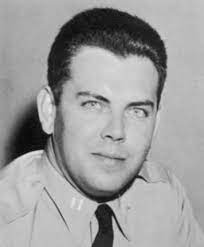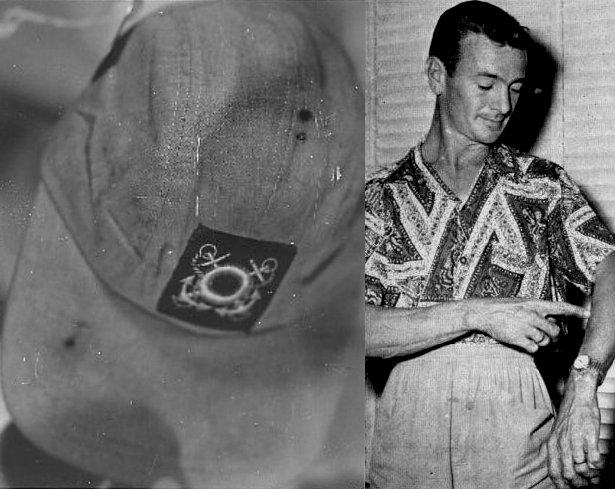by Charles Lear

There are cases throughout UFO history that continue to inspire debate, even though they’ve been declared hoaxes by most of the people who have looked into them. One such case came up early on near the beginning of the UFO mystery. It was investigated by Capt. Edward J. Ruppelt, then head of Project Blue Book, and 2nd Lt. Robert M. Olsson. In his 1956 book, The Report on Unidentified Flying Objects, Ruppelt tells the reader that it was officially labeled a hoax, and calls it “the best hoax in UFO history.” Even so, there were a couple of unexplained details that have left some researchers, such as Karl Pflock, wondering.
According to Ruppelt in his book, he got a call from Air Technical Intelligence Command (Wright-Patterson AFB, Dayton, Ohio, where Project Blue Book had its office) while he was in the shower getting ready for work. An “operational immediate” wire had just come in and Ruppelt was told that he should come in as soon as he could. When he got to ATIC, he learned that the wire was from an intelligence officer at a Florida airbase. It told of a report of a UFO encounter by a scoutmaster and three boy scouts. The scoutmaster was reportedly burned after getting too close and was described as a “solid citizen.” According to Ruppelt, transport on a B-25 was arranged, and he and Olsson headed to Florida.
When they got to the airbase, an intelligence officer there arranged for the scoutmaster to come to the base, and he got there within minutes, having expected the arrival of Ruppelt and Olsson. Ruppelt describes the scoutmaster as a pleasant man in his thirties, not very talkative, but “willing to cooperate.”
The man told them that he had lived in Florida his whole life, gone to military prep school, “some college,” and joined the marines. He’d been a car mechanic, owned a gas station, and was at that time, working as a clerk in a hardware store. A few months before, a local church established a Boy Scout troop and he volunteered to be a scoutmaster.
He said that he was driving three boys home after a scout meeting when he saw a light off to his left. He asked the boys if they’d seen it, and they said no. He then saw “lights,” and this time, the boys saw them too, and he stopped. He wanted to go into the woods, which consisted of scrub pines and palmetto thickets, and investigate, but the boys were afraid to stay in the car alone, so he drove on.
He said he became bothered by the possibility that what he’d seen had been a plane crashing, and he was moved to turn around and go back. A program that was scheduled to last fifteen minutes had just come on the radio, and he told the boys that if he wasn’t back by the time it was over, they should go to a nearby farmhouse they had passed and get help.
According to the scoutmaster, he went into the woods equipped with a machete, and he was wearing a denim cap with a bill. He said he went fifty feet in, and then, finding no path through a palmetto thicket, he ended up wading through waist-high brush. He perceived a faint odor (Ruppelt says that it was “actually more like a subconscious awareness”) and a slight increase in temperature. He worked his way through to a “clearing or one of the many ponds that dot the area.” He then became “consciously aware” of the odor and the heat.
He felt someone was watching him, looked up to find the North Star, and saw that a dark shape about thirty feet above him was blotting out the sky. He moved out from under it and the air was fresher and cooler.
He said he shone his flashlight on the shape and saw it was circular, with a smooth grey surface. He said there was a dome on top, that the edge of the craft was thick and had vanes spaced around it about one foot apart.
He said he felt a fury come over him and that he got the idea to attack the object with his machete. As soon as that idea came into his head, he saw the shadows on the dome change slightly, and he heard a noise “like the opening of a well-oiled safe door.”
He froze and watched as a small, red ball of fire floated towards him. It then expanded into a red mist. He covered his face with his arms and passed out as the mist enveloped him.
When the scoutmaster didn’t come back, the boys went to the farmhouse. The farmer there listened to their story, called the Florida State Highway Patrol, and someone there called the county sheriff’s office. A deputy sheriff and a constable came to the house and the boys were taken along with them back to the car.
The scoutmaster had regained consciousness and came upon the group as they pulled up. The deputy later told Ruppelt that he had never seen a person as scared as the scoutmaster was, who was barely able to tell his story.
Everyone went to the woods and they found a flashlight and grass that was flattened as if someone had been lying there. They marked the spot, the constable took the boys home, and the scoutmaster followed the deputy to the sheriff’s office.
The scoutmaster said that that was when he first noticed that his face and arms were burned, and when he got to the sheriff’s office, he found his cap had been burned as well. The deputy then called the Air Force.
According to Ruppelt, the scoutmaster kept asking, “What did I see?” and said that, even though the story had leaked to the papers, he was waiting for clearance from the Air Force before he spoke with the press. Ruppelt told him he was free to say anything he wanted.
 Ruppelt wrote that he spoke with the flight surgeon who had examined the scoutmaster, and he confirmed that there were burns on his arms and the backs of his hands. He added that his nostrils were burned as well and that his hair had been singed. According to him, the burns were minor and could have been made with a lighter. He suggested that Ruppelt should check the man’s Marine records.
Ruppelt wrote that he spoke with the flight surgeon who had examined the scoutmaster, and he confirmed that there were burns on his arms and the backs of his hands. He added that his nostrils were burned as well and that his hair had been singed. According to him, the burns were minor and could have been made with a lighter. He suggested that Ruppelt should check the man’s Marine records.
Ruppelt, Olsson, the deputy sheriff, the constable, and three people from the intelligence office went to the site. They tested for radiation and found nothing unusual. They also took soil and grass samples. Ruppelt and Olsson interviewed the scoutmaster’s employer and some of his friends, and they had nothing bad to say about him.
After returning to Dayton, Ruppelt learned that the scoutmaster had been discharged from the Marines after stealing a car and being AWOL, and that he’d also done time in a federal prison. He also learned that the man had hired a press agent.
 Ruppelt sent the machete, cap, and the soil and grass samples to be analyzed. Because the man portrayed in the records didn’t match the man described by the people Ruppelt and Olsson had interviewed, they returned and found more character witnesses, and this time, the man the new witnesses described matched the man in the records and they became convinced that the report was a hoax.
Ruppelt sent the machete, cap, and the soil and grass samples to be analyzed. Because the man portrayed in the records didn’t match the man described by the people Ruppelt and Olsson had interviewed, they returned and found more character witnesses, and this time, the man the new witnesses described matched the man in the records and they became convinced that the report was a hoax.
The lab that had examined the machete and hat found nothing unusual about the machete and could only confirm that the cap was indeed scorched, but found some tiny burns that “had very probably been made by an electrical spark.”
The lab that had examined the grass had found that the roots had been charred, while the part above the soil hadn’t been. It was determined at the lab that this could be duplicated by heating pans of grass in sandy soil to 300º F. Ruppelt couldn’t come up with an explanation as to what could have caused the charring at the site.
So, while the scoutmaster’s credibility was questionable, what caused the charring of the grass roots remains a mystery. Karl Pflock wrote a highly detailed 1997 paper on this case titled, The Best Hoax in UFO History?, where he identifies the scoutmaster as Dunham Sanborn “Sonny” Desvergers. He closed with this: “So, was this the best hoax in UFO history, or, as UFO historian Jerome Clark put it: ‘the ufologist’s worst nightmare: a real experience which happened to an unreliable individual.’”
Those wishing to look into this case in depth might want to click on this link:
https://www.saturdaynightuforia.com/html/articles/articlehtml/thescoutmasterstale.html
First question that comes to mind is “Were the 3 boy scouts ever interviewed?” What was their account of the incident?
Anyways, always enjoy reading these blogs, thanks.